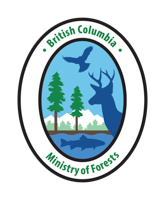Ongoing Research Projects at the Upper Penticton Creek Watershed
Forest regrowth and hydrological recovery:
As forests regenerate following logging, the effects of the changing forests on hydrological processes evolve but it is unclear when a forest is fully recovered. Ongoing monitoring of streamflow, snow accumulation, and snowmelt will help define forest recovery curves and develop an understanding of what hydrological recovery is. Here are ongoing research projects and results of the Upper Penticton Creek study.
Lodgepole pine (Pinus contorta ssp. latifolia) regenerates naturally following natural disturbance or harvesting, which often results in over-dense, uniform cohorts. Such overstocking impedes the healthy growth of trees, hampers their ability to produce merchantable volumes of wood, and may seriously affect carbon sequestration. This 3-block experimental trial established in 2016 aims at assessing the effects of thinning (two treatments) on carbon and water processes. It is financially and jointly supported by NSERC, UBC Okanagan and the BC Ministry of Forests, Lands, Natural Resource Operations and Rural Development.
Simulating the long term response of a headwater catchment to changes in land cover and climate:
A three-dimension integrated land surface-subsurface hydrologic model of the UPC 241 headwater catchment (Voeckler et al., 2014) has recently been updated to include a LiDAR-based digital elevation model, a network of fracture zones and a weathered bedrock layer. This updated model will be used to simulate the long term response of the catchment (water balance, groundwater recharge, and the contribution of groundwater to streamflow) to changes in land cover associated with various logging stages and variable climate conditions over the full history of the site.
Groundwater-surface water interactions:
While groundwater is an important contributor to streamflow at Upper Penticton Creek, it is still unclear how forest disturbance and regrowth affect shallow groundwater and the interactions between groundwater and the stream. Historic streamflow and shallow groundwater data will be used to model shallow groundwater processes. Further, new shallow groundwater wells have been installed to understand runoff processes and groundwater-surface water interactions.
Research Results
When forest cover was removed from over 50% of the watersheds at Upper Penticton Creek, water yield increased as a result of:
1. increased snow accumulation (10 – 25%)
2. increased rainfall reaching the soil surface (30%)
3. reduced water loss through transpiration and evaporation from the soil surface (15 to 30% of growing season rainfall),
• although chemical and physical water quality remains naturally high, logging and road construction led to slightly increased concentrations of Mg, Na, K, N and suspended sediment in stream water, particularly during snowmelt and rainstorms,
• recovery of water quality indicators was rapid (~3 years),
• aquatic invertebrate abundance and diversity were not adversely affected where stream channels and banks remained relatively undisturbed by logging,
• summertime low flows continued to decrease even two decades after logging commenced, likely due to advances in snowmelt timing and partial recovery of transpiration and interception losses in regenerating forests,
• heavy thinning of overstocked regenerating lodgepole pine forests had a positive effect on juvenile tree growth and limited water consumption during drought conditions.
Putting research into practice:
• consider opportunities to desynchronize snowmelt runoff within watersheds during cut block layout,
• identify and avoid potential sediment sources,
• locate roads to minimise stream crossings,
• keep fine logging slash out of creeks, and
• limit harvesting in riparian zones and areas hydrologically connected to streams.
